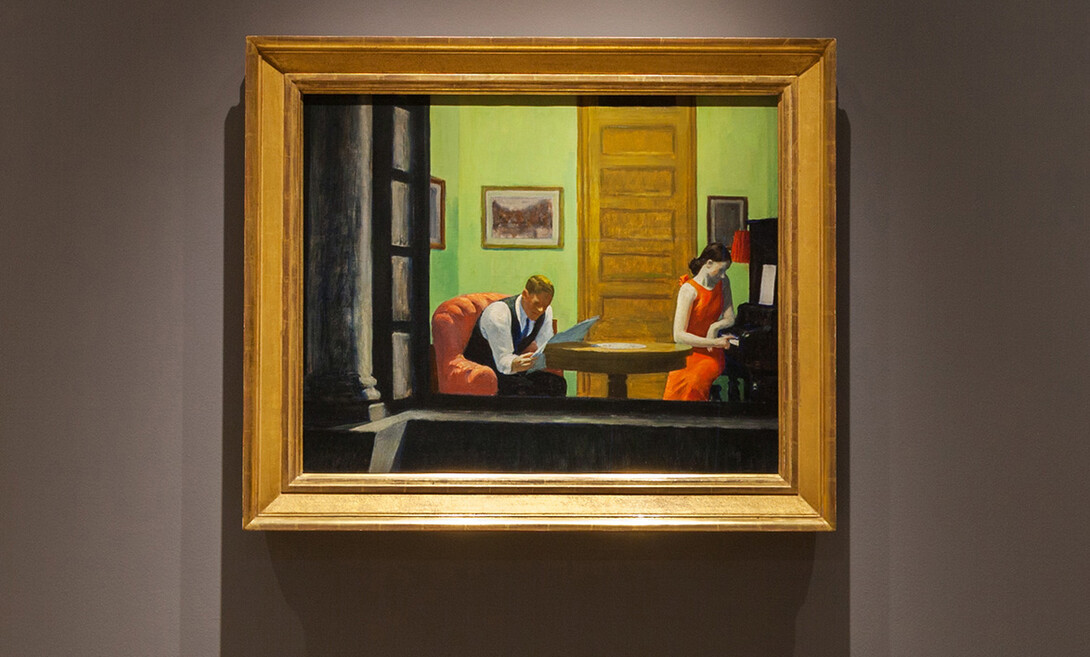
For 87 years, Edward Hopper’s iconic “Room in New York” has been among Sheldon Museum of Art’s most prestigious artworks –– and the fan favorite of visitors and scholars alike.
Since its purchase by the University of Nebraska in 1936, the painting has been continuously on view on campus in a variety of exhibitions. Additionally, this staple in the canon of American art has been loaned to more than 50 exhibitions worldwide. Most recently, it was featured in “Edward Hopper’s New York,” a major, retrospective exhibition of the artist’s work at the Whitney Museum of American Art in New York City.
“I want people to realize how special it is,” said Christian Wurst, Sheldon’s assistant curator of exhibitions. “We’re a university museum in Nebraska, and we have one of the best collections in the country, and we have one of the best Hopper paintings ever made.”
To celebrate the painting’s return home from the Whitney, Sheldon organized the exhibition “Sheldon Treasures: Edward Hopper and His Contemporaries,” which is on view through Dec. 21. Admission is free to the museum and its public programs.
Kim Conaty, Steven and Ann Ames Curator of Drawings and Prints and organizer of “Edward Hopper’s New York” at the Whitney, will present a public talk about Hopper and her research on Thursday, Oct. 19 at 5:30 p.m. at Sheldon.
Both the current exhibition and Conaty’s presentation give insight to the significance of Hopper and his contemporaries in the burgeoning art scene in New York City in the early 1900s.
As a resident of Lower Manhattan’s Washington Square neighborhood, Hopper wandered the city streets observing public and private moments of strangers’ lives, often through lighted window scenes at night. These observations inspired his compositions, which like “Room in New York” painted in 1932, show fleeting glimpses of city life based on imagined scenarios.
“[‘Room in New York’] had been in my mind a long time before I painted it,” Hopper said in 1935. “It was suggested by glimpses of lighted interiors seen as I walked along city streets at night… it is no particular street or house but is really a synthesis of many impressions.”
“Room in New York” gives viewers a look through the window of an anonymous couple. Hopper portrays a man preoccupied with his newspaper while a woman listlessly taps a piano key. It’s an evocative picture of isolation in modern urban living –– a timeless theme that keeps the painting relevant.
“I think we have different ways to detach ourselves from one another,” Wurst said. “This gentleman is reading a newspaper. If you were to do it today, you’d have him looking at his phone. I think those themes are consistent, universal ones that people can relate to.”
The painting debuted at the inaugural Whitney Biennial Exhibition of Contemporary American Art in 1932, where it received critical acclaim. “Room in New York” was brought to the University of Nebraska in March 1936 for the 46th annual painting exhibition of the Nebraska Art Association, now Sheldon Art Association. During this exhibition, the University of Nebraska purchased the painting from Hopper’s art dealer, New York gallerist Frank Rehn, with funds from the Anna R. and Frank M. Hall Charitable Trust. According to Wurst, the university acquired the painting at a time when Hopper was hitting his stride with national recognition and museums were competing with one another to purchase his art.
In an acquisition list prepared by former university galleries director Dwight Kirsch, Hopper’s painting and John Sloan’s “Back Yards, Greenwich Village” were noted as first choices over other artwork.
“I believe that both pictures are important examples of the work of the artists they represent and both Mr. Hopper and Mr. Sloan will undoubtedly be regarded as leaders among American artists in future years,” wrote Kirsch in his March 20, 1936 letter to then-Chancellor Edgar Allen Burnett, seeking authorization for the purchase.
Kirsch’s prediction was indeed borne out. The Sheldon exhibition emphasizes Hopper’s role among the early 20th-century artists who shaped modern American art. Opening with a floor-to-ceiling map of the city marked with key locations and events, the exhibition displays “Room in New York” among paintings by revered artists Walt Kuhn, Yasuo Kuniyoshi, Georgia O’Keeffe, Guy Pène Du Bois and Joseph Stella.
“When we brought it back, we didn’t just want to put it up on a wall and write a label for it,” Wurst said. “We wanted to have a show around it because it’s really never been contextualized in a show before here. And it’s one of those paintings in our collection that’s a standout—one that everybody knows about and expects to see.”
Sheldon Museum of Art is open Tuesday through Saturday, 10 a.m. to 4 p.m. Admission is free.







